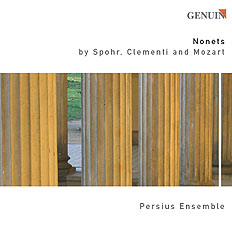Persius Ensemble

Ludwig Persius (1803–1845) was the royal architect of Prussian King Frederick William IV. Born in Potsdam, he was a pupil of Karl Friedrich Schinkel (1781–1841), and through the inspirational power of his castles and villas left an indelible stamp on the city of Potsdam in and around Sanssouci Park.
In 1998 five woodwind soloists, the concertmaster and three first-chair players in the ranks of the Brandenburgische Philharmonie Potsdam—which still existed until 2000— broke new ground by combining the arts of music and architecture in a combined concert and lecture performed at a location of historical and cultural interest. This experiment quickly became the popular concert series, Musik und Architektur, which can look back
today on more than 20 different projects—sufficient cause for the nine-member ensemble to take for itself the name of Ludwig Persius, who served in the court of the Prussian king at the same time as Felix Mendelssohn Bartholdy (1809–1847).
As the Persius Ensemble they are able to keep the number of instruments flexible and prefer to see themselves as a small symphony orchestra. Ensembles involving a larger group of chamber musicians used to be called petite symphonie in the circle of French composer Louise Farrenc (1804–1875), herself the composer of a nonet.
Today, the Persius Ensemble is invited to perform at important festivals and is a welcome guest at well-known concert series across Germany. Joy in performing music and the vivacity of their technically accomplished readings are hallmarks of the ensemble repeatedly praised by the critical press. At the same time, it is the seldom performed works in their repertoire as well as the arrangements of large-scale symphonic works which arouse particular
interest.
Ludwig Persius (1803–1845) was the royal architect of Prussian King Frederick William IV. Born in Potsdam, he was a pupil of Karl Friedrich Schinkel (1781–1841), and through the inspirational power of his castles and villas left an indelible stamp on the city of Potsdam in and around Sanssouci Park.
In 1998 five woodwind soloists, the concertmaster and three first-chair players in the ranks of the Brandenburgische Philharmonie Potsdam—which still existed until 2000— broke new ground by combining the arts of music and architecture in a combined concert and lecture performed at a location of historical and cultural interest. This experiment quickly became the popular concert series, Musik und Architektur, which can look back
today on more than 20 different projects—sufficient cause for the nine-member ensemble to take for itself the name of Ludwig Persius, who served in the court of the Prussian king at the same time as Felix Mendelssohn Bartholdy (1809–1847).
As the Persius Ensemble they are able to keep the number of instruments flexible and prefer to see themselves as a small symphony orchestra. Ensembles involving a larger group of chamber musicians used to be called petite symphonie in the circle of French composer Louise Farrenc (1804–1875), herself the composer of a nonet.
Today, the Persius Ensemble is invited to perform at important festivals and is a welcome guest at well-known concert series across Germany. Joy in performing music and the vivacity of their technically accomplished readings are hallmarks of the ensemble repeatedly praised by the critical press. At the same time, it is the seldom performed works in their repertoire as well as the arrangements of large-scale symphonic works which arouse particular
interest.
CDs released by GENUIN
with Persius Ensemble










